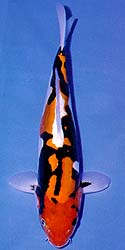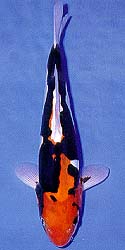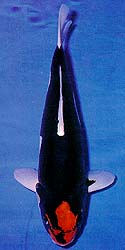"Kawarigoi or Tategoi?" Kawarigoi is the name given to the "catch all" category that contains all the varieties, named and unnamed, that do not fit into any other categories. This category of "Kawarigoi", formerly referred to as "Kawarimono", contains literally hundreds of different types of koi. (This can result in great confusion when someone says "I'm looking for a Kawarimono.") The word "Tategoi" is perhaps the most overused, misused and abused word in the Japanese language. A few often-misused definitions follow:
Although Tategoi has been (thoroughly) misinterpreted as meaning a koi that will improve with time, the true meaning of Tategoi is a koi that should or will, be grown on with the hope of attaining further potential. Mr. Tokutake, a well respected member of the Zen Nippon Airinkai and Certified ZNA Koi Judge, shared the following views on Tategoi. "Keeping Tategoi is never an easy task," he said. "When I purchase 10 of the highest grade Tategoi in the spring, if even one of them turns out the way I had hoped for at the end of the growing season, I consider myself very fortunate!" In the fall of 1995, this Kawarigoi took the 1st place Kawagoi and prestigious Agricultural Minister's Award at the Agricultural Koi Show at Ojiya city in Niigata. It was entered by breeder Mr. K. Hirasawa who created this specimen by crossing a Doitsu Showa with a Kumonryu.
The unique qualities of this koi created quite a lot of interest at the show, resulting in a number of persons vying for ultimate ownership. The koi subsequently vanished from public view, only to resurface three months later at the 28th All Japan Show, entered by Dr. Noboru Yamamoto, from Shinjuku in Tokyo. Many of you who have traveled to Japan are probably familiar with the Shinjuku district of Tokyo. Besides being the major hub for rail transportation throughout Japan, it is also affectionately referred to as Sin-juku or Sin City, famous for it's colorful night life. All that has absolutely nothing to do with koi, but what it does mean, is that space is at an absolute premium in Shinjuku, and to find a place to build a koi pond requires either extreme ingenuity or millions of dollars. The only space available for a koi pond at Dr. Yamamoto's residence was an area barely large enough to park a car. (Parking spaces in Shinjuku rent for over $1,000.00 per month!) In order to have his koi housed comfortably in an adequate facility, Dr. Yamamoto wanted to have a 13,000 gallon pond, a size that was unheard of in the heart of Tokyo. Dr. Yamamoto solved his problem by excavating in such a way that 80% of his 13,200 gallon pond lies under his house! It is in this semi-subterranean koi pond, that Dr. Yamamoto has kept this Kawarigoi over the last several years. Due to the Kumonryu parentage, and perhaps accelerated by the unique pond conditions that it is kept in, this Kawarigoi has changed radically in a relatively short period of time. When I first saw it at the Agriculture Show in Ojiya, its beni (red) was a soft persimmon color - so close to orange as to earn it the name "Halloween Koi" from some American visitors from Oregon. Over time, the beni has developed into the deep Showa red that it has today. In true Kumonryu fashion, the sumi (black) continues to develop totally out of control, without rhyme nor reason. In its present state, the sumi threatens to overrun the entire body, raising the possibility of a brief career as a Karasugoi!* To date, this koi has a perfect record. It has taken top honors in its class in every show it has ever been entered in, and Dr. Yamamoto assures me that he still considers his Kawarigoi to be a Tategoi, and that this is one Tategoi that he definitely won't be letting go of! *Karasugoi: Also referred to as simply Karasu. A koi that is entirely black when viewed from the top. (It can have a white, gold, red, orange or yellow belly.) Usually a fully scaled koi. Sometimes referred to as a Crow in the english language.
BACK TO TOP |
||||||||||||
|
|
||||||||||||



